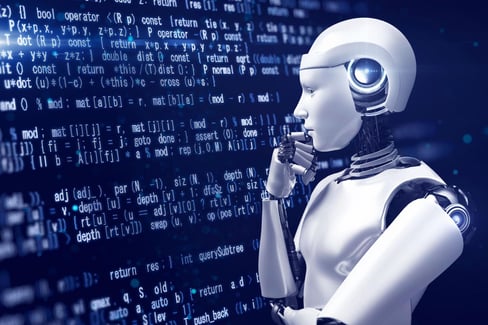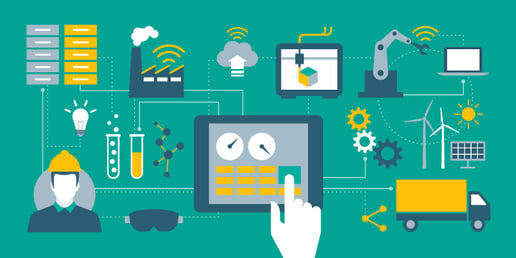What is it?
Hello, Industrial Leaders! Are you pondering the integration of AI into your operations but uncertain about your organization's readiness? Our AI Readiness Quiz is crafted specifically for you. It's straightforward, clear, and actionable, guiding you through the crucial aspects of AI readiness in your industry.
Take the Quiz now, or get to know more about what we will ask you.
1. Organizational Understanding of AI
AI can revolutionize how you handle operations, from predictive maintenance to optimizing workflows. But first, understand what AI is and isn't. AI is not a magical solution; it's a strategic tool that enhances efficiency and decision-making. As technology evolves, implementing AI becomes not just an option but a necessity for companies aiming to stay competitive and efficient. It's a technique that, sooner or later, will become integral to your business processes.
Embrace AI, don't fear it. Understand that AI is about leveraging technology to work smarter. It's an opportunity to enhance your operations, not a threat to your existing processes. By demystifying AI and viewing it as a practical, approachable tool, you can prepare your organization to harness its potential effectively. This mindset shift is crucial for leaders and managers in adapting to and benefiting from AI advancements.
 2. Leadership and Management Buy-In
2. Leadership and Management Buy-In
Implementing AI is a significant change that requires the involvement and agreement of all teams. It's essential to understand that AI integration isn't just the responsibility of a single team; its real value unfolds when it's utilized across various company teams and integrated into every aspect of the industrial process.
To ensure a successful AI implementation, it's crucial to have a unified vision across the organization. This means getting buy-in from every department, from engineering to operations to HR. Leaders and managers must advocate for this technology, highlighting how AI can benefit each area of the business.
Remember, adopting AI requires resources – both financial and human. It's important to include these in your project costs and budgeting. While there is an upfront investment, the focus should be on the long-term profitable return that AI can bring. Effective communication about the potential ROI and efficiency gains is key to securing the necessary support and resources.
3. Strategic Alignment and Operational Readiness
As you embark on your AI journey, it's crucial to have clear KPIs, goals, case studies, budgets, tools, and a dedicated team. Ensure everything is in place to kick off effectively once you find the right tool or partner.
Start with a well-defined Phase 1. This initial phase should be manageable yet impactful enough to demonstrate the potential of AI in your operations. However, don't just stop there. Plan for scalability and expansion. Envision how the project will evolve if successful – what will be the next process to tackle? Also, have a contingency plan in place. Decide in advance at what point you might cut your losses or pivot to a different strategy if things don't go as planned.
It's also vital to consider how Phase 1 aligns with your broader business strategy. Will the outcomes of this initial phase be sufficient to convince the management team to expand AI integration to other factories or production lines? Understanding this fit is crucial for securing ongoing support and investment in your AI initiatives.
4. Technical Infrastructure
For AI to be successfully integrated into your industrial operations, the collaboration between IT (Information Technology) and OT (Operational Technology) teams is crucial. These teams must work together to understand how data from machinery and assets can be a valuable asset to your organization.
AI requires a robust set of tools to function effectively. You need systems to build AI solutions (algorithms), host them, run them, deploy them, and retrain them. All these aspects must be considered. While there are multiple tools available in the industry, comprehensive solutions like Wizata offer an all-in-one approach.
Connecting data to a single time-series database is vital. Discuss with operators, engineers, and data scientists to understand the volume of data needed, the frequency of data collection, and other specifics. This data is crucial for building AI models that improve processes.
Be aware that integration is not just plug-and-play. You may have different machines and sensors, each with its own data language (protocols). Your team will need to standardize this using existing tools like OPC-UA (a standard protocol) to ensure all data flows seamlessly to a unified platform, such as Wizata.
5. Data Readiness
The first step in data readiness is understanding what data you need. Focus on the problem you want to solve. How do you measure that problem, and what is the goal or outcome you want to achieve? This will guide you in determining what data to collect. For instance, if you aim to reduce energy consumption, consider all assets in your production line that consume energy. Track how much each asset spends individually and the overall expenditure. Then, decide how you want to present your goal – whether as a percentage improvement or in actual monetary gains. For this, you might need specific data, like the price of each kilowatt-hour.
Consider whether cloud solutions like Wizata are feasible for your organization or if internal restrictions necessitate on-premise solutions. Be aware of security concerns, such as how your intellectual property and algorithms are stored and who owns the new solutions you're building.
Also, assess what data you're missing and how you can obtain it. Sometimes, you already have everything you need to start. Understand your goals, your case study, and what data you have, and based on that, determine if an AI solution is feasible. If you're already using data but struggling to build AI solutions, tools like Wizata can help bridge that gap.

6. Talent and Expertise
Building AI can be daunting. Assess whether you have the necessary talent in-house or need to look externally. Working with partners who can help kick off your AI journey and then train your team to take over is a viable approach. This collaboration can help your team grow alongside the technology.
Consider leveraging low-code solutions that empower your engineers and data scientists to build, replicate, and scale quickly. Tools that offer pre-packaged AI solutions can be a great starting point for integrating AI into your processes. For example, Wizata's Anomaly Detection Wizard lets you detect anomalies from your dataset in seconds. These tools can provide a practical, hands-on way for your team to engage with AI without needing deep technical expertise from the outset.
7. Business Impact and ROI
When it comes to calculating ROI, it's essential to look beyond mere expenditure and outcome. Consider the involvement of your team, the cost of assets, and the savings from reduced asset turnover or downtime. Set a clear, primary KPI to focus on and measure the before and after. Remember, with AI, there are often secondary gains, but concentrating on one main KPI is crucial for clarity and focus.
Some of our clients at Wizata start by running AI models for hours or days to test them and observe the results before moving forward to a full AI closed-loop production, which is the ultimate goal. This approach allows for a gradual integration and a clear understanding of the AI's impact.
Ensure you have a realistic estimation of the costs and a realistic timeline. Implementing AI doesn't yield immediate ROI; readiness in terms of technical infrastructure, team management, and data is crucial—factor in these elements when considering your timeline for seeing returns on your AI investment.
Conclusion and Next Steps
You're now equipped with the knowledge to assess your organization's AI readiness. Take this Quiz, evaluate each area, and plan your AI journey with confidence.
Remember, integrating AI into your industrial processes is a journey, not a one-time event. It requires continuous effort, learning, and adaptation. But with the right approach and resources, you can harness the power of AI to drive significant improvements in your operations.
Ready to start building your AI project?






